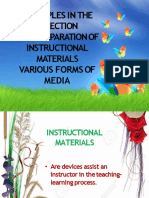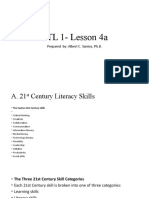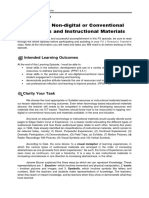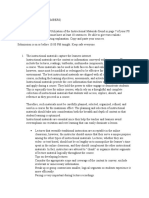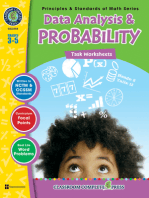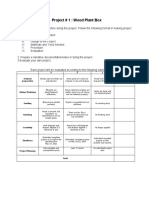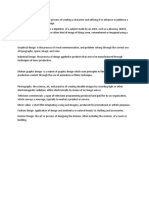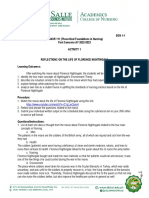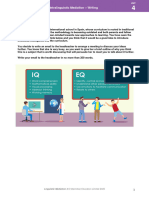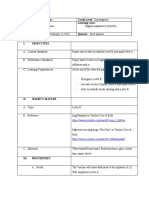0 ratings0% found this document useful (0 votes)
68 viewsGuiding Principles in The Selection and Use of Instructional Materials
Guiding Principles in The Selection and Use of Instructional Materials
Uploaded by
John Rey SR SoveranoInstructional materials are aids used to assist instructors in teaching and transferring information to students. They are supplementary tools that support, supplement, or reinforce instruction. Effective instructional materials highlight important concepts, are organized into chunks for easy recall, and are designed to cover key points straightforwardly. Reasons for using instructional materials include helping students remember information, gaining attention, clarifying relationships between concepts, and addressing language barriers. Principles for selecting materials include choosing aids that suit learning objectives and using a variety to engage students through varied modalities.
Copyright:
© All Rights Reserved
Available Formats
Download as DOCX, PDF, TXT or read online from Scribd
Guiding Principles in The Selection and Use of Instructional Materials
Guiding Principles in The Selection and Use of Instructional Materials
Uploaded by
John Rey SR Soverano0 ratings0% found this document useful (0 votes)
68 views2 pagesInstructional materials are aids used to assist instructors in teaching and transferring information to students. They are supplementary tools that support, supplement, or reinforce instruction. Effective instructional materials highlight important concepts, are organized into chunks for easy recall, and are designed to cover key points straightforwardly. Reasons for using instructional materials include helping students remember information, gaining attention, clarifying relationships between concepts, and addressing language barriers. Principles for selecting materials include choosing aids that suit learning objectives and using a variety to engage students through varied modalities.
Original Title
Guiding Principles in the Selection and Use of Instructional Materials
Copyright
© © All Rights Reserved
Available Formats
DOCX, PDF, TXT or read online from Scribd
Share this document
Did you find this document useful?
Is this content inappropriate?
Instructional materials are aids used to assist instructors in teaching and transferring information to students. They are supplementary tools that support, supplement, or reinforce instruction. Effective instructional materials highlight important concepts, are organized into chunks for easy recall, and are designed to cover key points straightforwardly. Reasons for using instructional materials include helping students remember information, gaining attention, clarifying relationships between concepts, and addressing language barriers. Principles for selecting materials include choosing aids that suit learning objectives and using a variety to engage students through varied modalities.
Copyright:
© All Rights Reserved
Available Formats
Download as DOCX, PDF, TXT or read online from Scribd
Download as docx, pdf, or txt
0 ratings0% found this document useful (0 votes)
68 views2 pagesGuiding Principles in The Selection and Use of Instructional Materials
Guiding Principles in The Selection and Use of Instructional Materials
Uploaded by
John Rey SR SoveranoInstructional materials are aids used to assist instructors in teaching and transferring information to students. They are supplementary tools that support, supplement, or reinforce instruction. Effective instructional materials highlight important concepts, are organized into chunks for easy recall, and are designed to cover key points straightforwardly. Reasons for using instructional materials include helping students remember information, gaining attention, clarifying relationships between concepts, and addressing language barriers. Principles for selecting materials include choosing aids that suit learning objectives and using a variety to engage students through varied modalities.
Copyright:
© All Rights Reserved
Available Formats
Download as DOCX, PDF, TXT or read online from Scribd
Download as docx, pdf, or txt
You are on page 1of 2
Guiding Principles in the Selection and Use of Instructional Materials
1. 1. WHAT ARE INSTRUCTIONAL MATERIALS? •Devices that assist an instructor in the
teaching- learning process. These are materials that are used to aid in the transference of
information from one to another. •Instructional aids are not self-supporting; they are
supplementary training devices. The key factor is that instructional aids support, supplement,
or reinforce.
2. 2. WHEN DO WE USED INSTRUCTIONAL MATERIALS? •YOU USE INSTRUCTIONAL
MATERIALS WHEN YOU TEACH SOMETHING. EX. BOOKS, CHARTS, GRAPHS,
PICTURES, WORKSHEETS, AUDIO CDS/DVDS, VIDEOS
3. 3. •For many years, educators have theorized about how the human brain and the memory
function during the communicative process. There is general agreement about certain
theoretical factors that seem pertinent to understanding the use of instructional aids.
INSTRUCTIONAL AID THEORY
4. 4. INSTRUCTIONAL AID THEORY •During the communicative process, the sensory register
of the memory acts as a filter. As stimuli are received, the individual's sensory register works
to sort out the important bits of information from the routine or less significant bits. within
seconds, what is perceived as the most important information is passed to the working or
short-term memory where it is processed for possible storage in the long-term memory. This
complex process is enhanced by the use of appropriate instructional aids that highlight and
emphasize the main points or concepts.
5. 5. INSTRUCTIONAL AID THEORY •The working or short-term memory functions are limited
by both time and capacity. Therefore, it is essential that the information be arranged in useful
bits or chunks for effective coding, rehearsal, or recording. The effectiveness of the
instructional aid is critical for this process. Carefully selected charts, graphs, pictures, or
other well-organized visual aids are examples of items that help the student understand, as
well as retain, essential information.
6. 6. INSTRUCTIONAL AID THEORY •Ideally, instructional aids should be designed to cover
the key points and concepts. In addition, the coverage should be straightforward and factual
so it is easy for students to remember and recall. Generally, instructional aids that are
relatively simple are best suited for this purpose.
7. 7. INSTRUCTIONAL AID THEORY
8. 8. REASONS FOR USE OF IMS •1. It helps the students remember important information.
•2. When properly used, they help gain and hold the attention of students.
9. 9. •3. Audio or visual aids can be very useful in supporting a topic, and the combination of
both audio and visual stimuli is particularly effective since the two most important senses are
involved. Instructors should keep in mind that they often are salesmen of ideas, and many of
the best sales techniques that attract the attention of potential clients are well worth
considering. One caution-the instructional aid should keep student attention on the subject; it
should not be a distracting gimmick. REASONS FOR USE OF IMS
10. 10. •4. Good instructional aids also can help solve certain language barrier problems.
Consider the continued expansion of technical terminology in everyday usage. This, coupled
with culturally diverse backgrounds of today's students, makes it necessary for instructors to
be precise in their choice of terminology. Words or terms used in an instructional aid should
be carefully selected to convey the same meaning for the student as they do for the
instructor. They should provide an accurate visual image and make learning easier for the
student. REASONS FOR USE OF IMS
11. 11. •5. Another use for instructional aids is to clarify the relationships between material
objects and concepts. When relationships are presented visually, they often are much easier
to understand. For example, the subsystems within a physical unit are relatively easy to
relate to each other through the use of schematics or diagrams. Symbols, graphs, and
diagrams can also show relationships of location, size, time, frequency, and value. By
symbolizing the factors involved, it is even possible to visualize abstract relationships.
REASONS FOR USE OF IMS
12. 12. To encourage your student in their lesson and get their attention Improve the delivery of
instruction Creation of effective, meaningful lessons Helps students make sense of
information Instructional Materials serve as the channel between the teacher and the
students in delivering the instruction. For learners have a clear view of what is being taught.
Importance of IMs
13. 13. PRINCIPLES OF SELECTION AND USE OF INSTRUCTIONAL MATERIALS •All
instructional materials are aids to instruction. They do not replace the teacher. •Choose the
instructional material that best suits your instructional objectives. Decide what you want to
accomplish and then employ the tools that are most likely to achieve results. Do not let the
media that is available to you determine how or what you will teach.
14. 14. PRINCIPLES OF SELECTION AND USE OF INSTRUCTIONAL MATERIALS •If
possible, use a variety of tools. Using videos, computers, overheads and the chalkboard not
only keeps students’ interest but also responds to the needs of those who receive
information in different ways.
15. 15. PRINCIPLES OF SELECTION AND USE OF INSTRUCTIONAL MATERIALS •Check out
your instructional materials before class starts to be sure it is working properly. Nothing is
more frustrating to you or to your students in the process of the instruction than to find that
the overhead projector, for instance, does not work in the process of instruction.
16. 16. PRINCIPLES OF SELECTION AND USE OF INSTRUCTIONAL MATERIALS •For
results, abide by the general utilization guide on the use of media given below: • Learn how
to use the instructional material. Before using it, make sure you know how to manipulate it to
obtain the desired product. Listen to the record or view the film ahead. Check the correct size
and complete parts of real objects, photographs or models to be presented. • Prepare
introductory remarks, question or initial comments you may need. • Provide a conducive
environment; arrange the chairs, tables and the equipment and materials. Provide sufficient
lightning and ventilation. • Explain the objective of the lesson. • Stress what is to be watched
or listened to carefully. • State what they will be expected to do with the information they will
learn. Discussion or a test may follow. • There is need to summarize or review the
experience. Prepare measures that can assess their gains based on the objectives.
17. 17. GUIDELINES FOR INSTRUCTIONAL AIDS •Support the lesson objective. •Be student
centered. •Build on previous learning.
18. 18. GUIDELINES FOR INSTRUCTIONAL AIDS •Contain useful and meaningful content that
is consistent with sound principles of learning. •Appeal to students.
19. 19. GUIDELINES FOR INSTRUCTIONAL AIDS •Maintain student attention and interest.
•Encourage student participation, when appropriate.
20. 20. GUIDELINES FOR INSTRUCTIONAL AIDS •Lead students in the direction of the
behavior or learning outcomes specified in the learning objective.
21. 21. GUIDELINES FOR INSTRUCTIONAL AIDS •Provide proper stimuli and reinforcement.
•Contain quality photos, graphs, and text as required
22. 22. GUIDELINES FOR INSTRUCTIONAL AIDS •Be checked prior to use for completeness
and technical accuracy •Contain appropriate terminology for the student. •Be properly
sequenced.
23. 23. GUIDELINES FOR INSTRUCTIONAL AIDS •Be easy to understand. •Include
appropriate safety precautions.
24. 24. YOU MAY DOWNLOAD THE COMPLETE GUIDELINES OF INSTRUCTIONAL AIDS
AND THE COPY OF MY REPORT AT THESE LINKS •bit.ly/instrumat2017 •bit.ly/instrumppt
You might also like
- Guidelines in Instructional AidsDocument32 pagesGuidelines in Instructional AidsDepEdResources100% (5)
- CULMINATINGDocument23 pagesCULMINATINGLeo Walican AntonioNo ratings yet
- Module 2 - Guiding Principles in The Selection and Use of Instructional MaterialsDocument4 pagesModule 2 - Guiding Principles in The Selection and Use of Instructional MaterialsPalencia CindyNo ratings yet
- Learning Theories Related To Educational Technology: TECHNOLOGY Allows The Students and Teachers To Live Within TheDocument18 pagesLearning Theories Related To Educational Technology: TECHNOLOGY Allows The Students and Teachers To Live Within TheLovely CorreaNo ratings yet
- 6 Guiding Principles in The Selection and Use of Instructional MaterialsDocument27 pages6 Guiding Principles in The Selection and Use of Instructional MaterialsKJ Marquez100% (1)
- Chapter 6 Guiding Principles in The Selection and Use of Instructional Materials Ims Ryan Marquez DIT2BDocument10 pagesChapter 6 Guiding Principles in The Selection and Use of Instructional Materials Ims Ryan Marquez DIT2BJOMAR OLOLNo ratings yet
- Instructional Materials (Or Aids)Document12 pagesInstructional Materials (Or Aids)Michelle CabañogNo ratings yet
- Instructional MaterialsDocument27 pagesInstructional Materialsvricxzs93% (40)
- Ect 300 Online Class October 2024Document23 pagesEct 300 Online Class October 2024Renick WanyonyiNo ratings yet
- What Is Instructional Media?Document15 pagesWhat Is Instructional Media?Emishaw DemisieNo ratings yet
- MAKING IMs USING OPEN-ENDED TOOLSDocument20 pagesMAKING IMs USING OPEN-ENDED TOOLSApril Concepcion100% (1)
- ASSURE ModelDocument27 pagesASSURE ModelJoelynn KhooNo ratings yet
- UntitledDocument36 pagesUntitledZahid ImranNo ratings yet
- Aparente Teaching Internship Activity Episode 3Document5 pagesAparente Teaching Internship Activity Episode 3Mirasol AparenteNo ratings yet
- Fs 2 Episode 12Document9 pagesFs 2 Episode 12mikko ibiasNo ratings yet
- Implementing CurriculumDocument45 pagesImplementing Curriculumtadz jawaliNo ratings yet
- Meaning of Educational Technolog:: Activity No. 1Document11 pagesMeaning of Educational Technolog:: Activity No. 1Jane Leizl LozanoNo ratings yet
- Educational TechnologyDocument7 pagesEducational TechnologyEfren TurajaNo ratings yet
- Online-Curriculum-Chapter 8 & 9Document11 pagesOnline-Curriculum-Chapter 8 & 9Lovelyn MaristelaNo ratings yet
- Production of Social Studies Intructional MaterialsDocument53 pagesProduction of Social Studies Intructional MaterialsDanny Delos Santos BautistaNo ratings yet
- FS2 Ep12Document8 pagesFS2 Ep12Josirene LariosaNo ratings yet
- EPP Teaching Strategies and Assessment EDUC 110 BEEDDocument43 pagesEPP Teaching Strategies and Assessment EDUC 110 BEEDKim VyNo ratings yet
- FS 2 Module 1Document27 pagesFS 2 Module 1Francisco75% (8)
- Lesson 3: The ASSURE ModelDocument6 pagesLesson 3: The ASSURE Modelhaizelle resmaNo ratings yet
- Principles in The Selection of Instructional MaterialsDocument11 pagesPrinciples in The Selection of Instructional MaterialsJesullyna C. ManuelNo ratings yet
- The ASSURE Mode1Document5 pagesThe ASSURE Mode1Melendez, Abegail T.No ratings yet
- Inbound 314111087807000669Document26 pagesInbound 314111087807000669lesterposadas19No ratings yet
- Chapter 7-10Document10 pagesChapter 7-10Nikki RodriguezNo ratings yet
- Assure ModelDocument22 pagesAssure ModelMaria Camila ManaloNo ratings yet
- FS2-LearningEpisode-10 FINALDocument9 pagesFS2-LearningEpisode-10 FINALTrendy PorlageNo ratings yet
- Lesson 4 - TTL 1 Educ 302Document46 pagesLesson 4 - TTL 1 Educ 302Mark Jerick RamosNo ratings yet
- 4 PrintDocument2 pages4 Printapi-263506256No ratings yet
- Standard Curriculum and PartsDocument10 pagesStandard Curriculum and PartsJoy AcobNo ratings yet
- B. Which Projected and Non-Projected Aids Are Suitable For Teaching Science Elementary Level Justify With Examples?Document23 pagesB. Which Projected and Non-Projected Aids Are Suitable For Teaching Science Elementary Level Justify With Examples?Abdul BasitNo ratings yet
- Different Approaches and Methods: "A Thousand Teachers, A Thousandmethods."Document49 pagesDifferent Approaches and Methods: "A Thousand Teachers, A Thousandmethods."John Jufel ValdezNo ratings yet
- Taeled803 Assessment Smcm20200252Document32 pagesTaeled803 Assessment Smcm20200252Nirmala TamangNo ratings yet
- AssureDocument16 pagesAssureJessa AbelgasNo ratings yet
- Instructional Materials and Their Kinds of Instructional Aids and Their UsesDocument38 pagesInstructional Materials and Their Kinds of Instructional Aids and Their UsesOzelle PoeNo ratings yet
- Instructional Materials and Their Kinds of Instructional Aids and Their UsesDocument38 pagesInstructional Materials and Their Kinds of Instructional Aids and Their Usesclara dupitasNo ratings yet
- Midterm Examination Mse Tle 215 - Development and Utilization of Intructional Materials in TLEDocument7 pagesMidterm Examination Mse Tle 215 - Development and Utilization of Intructional Materials in TLEGian Daniela GalantoNo ratings yet
- FS 2 Episode 3Document11 pagesFS 2 Episode 3May Ann OmoyonNo ratings yet
- Chapter 6Document6 pagesChapter 6Blessie Kaye AbelleraNo ratings yet
- Principles of TeachingDocument49 pagesPrinciples of TeachingJoviner Yabres LactamNo ratings yet
- Instructional Materials PreparationDocument31 pagesInstructional Materials PreparationJuhaira DatuwataNo ratings yet
- Selection and Use of Instructional MaterialsDocument21 pagesSelection and Use of Instructional Materialsmary grace sierraNo ratings yet
- FS 2 LE 7 Act1 FINALDocument5 pagesFS 2 LE 7 Act1 FINALChelcie Anne CanlasNo ratings yet
- The ASSURE Model: Human Resource DevelopmentDocument9 pagesThe ASSURE Model: Human Resource DevelopmentChee Mei YinNo ratings yet
- Assignment in SPEC14: (Preparation and Evaluation of Instructional Materials)Document9 pagesAssignment in SPEC14: (Preparation and Evaluation of Instructional Materials)Jai-JaiAdalidNo ratings yet
- Chapter One Background To The StudyDocument35 pagesChapter One Background To The StudyAjibade TaofikNo ratings yet
- Selecting Non-Digital or Conventional Resources and Instructional MaterialsDocument7 pagesSelecting Non-Digital or Conventional Resources and Instructional MaterialsCholo Miraflores DeguzmanNo ratings yet
- Teaching Strategies: Ncm102/N: Health EducationDocument48 pagesTeaching Strategies: Ncm102/N: Health EducationCasey Wruble100% (1)
- Ed Tecth Leson CompleteDocument19 pagesEd Tecth Leson CompleteEva Joy DelacruzNo ratings yet
- Group ActivityDocument4 pagesGroup ActivityJanito, Mariel K.No ratings yet
- To SendDocument14 pagesTo SendJamille Nympha C. BalasiNo ratings yet
- Nature and Scope of Epp/Tle With Entrep: Prepared By: Group 1 ReportersDocument20 pagesNature and Scope of Epp/Tle With Entrep: Prepared By: Group 1 ReportersSasha Tan100% (1)
- Assure ModelDocument5 pagesAssure ModelDessirie EnriquezNo ratings yet
- De Vera, Kyle C. - Guiding Principles in The Use of Instructional MaterialsDocument2 pagesDe Vera, Kyle C. - Guiding Principles in The Use of Instructional MaterialsKyree VladeNo ratings yet
- Teaching Basic Engineering mechanics for optimum student involvementFrom EverandTeaching Basic Engineering mechanics for optimum student involvementNo ratings yet
- Data Analysis & Probability - Task & Drill Sheets Gr. 6-8From EverandData Analysis & Probability - Task & Drill Sheets Gr. 6-8No ratings yet
- Data Analysis & Probability - Task & Drill Sheets Gr. 3-5From EverandData Analysis & Probability - Task & Drill Sheets Gr. 3-5No ratings yet
- Wood Plant BoxDocument8 pagesWood Plant BoxJohn Rey SR SoveranoNo ratings yet
- Produce Organic Concoctions and Extract PresentationDocument121 pagesProduce Organic Concoctions and Extract PresentationJohn Rey SR SoveranoNo ratings yet
- Using and Evaluating Instructional MaterialsDocument23 pagesUsing and Evaluating Instructional MaterialsJohn Rey SR SoveranoNo ratings yet
- Information SheetDocument29 pagesInformation SheetJohn Rey SR SoveranoNo ratings yet
- Educational TechnologyDocument56 pagesEducational TechnologyJohn Rey SR SoveranoNo ratings yet
- Development and Use of Non Digital or Conventional MaterialsDocument27 pagesDevelopment and Use of Non Digital or Conventional MaterialsJohn Rey SR SoveranoNo ratings yet
- Present Contrived Experiences and Their Various Forms by Means of A Graphic OrganizerDocument2 pagesPresent Contrived Experiences and Their Various Forms by Means of A Graphic OrganizerJohn Rey SR SoveranoNo ratings yet
- Activity 5: Produce Organic FertilizersDocument1 pageActivity 5: Produce Organic FertilizersJohn Rey SR SoveranoNo ratings yet
- Bishop GainzaDocument2 pagesBishop GainzaJohn Rey SR SoveranoNo ratings yet
- Challenges of Handicraft IndustriesDocument11 pagesChallenges of Handicraft IndustriesJohn Rey SR SoveranoNo ratings yet
- Activity 4: Produce Organic VegetablesDocument1 pageActivity 4: Produce Organic VegetablesJohn Rey SR SoveranoNo ratings yet
- Activity 6 MarcottingDocument3 pagesActivity 6 MarcottingJohn Rey SR SoveranoNo ratings yet
- Philippine Handicraft IndustryDocument18 pagesPhilippine Handicraft IndustryJohn Rey SR SoveranoNo ratings yet
- Meaning of Educational TechnologyDocument26 pagesMeaning of Educational TechnologyJohn Rey SR SoveranoNo ratings yet
- Commercial Arts DesignDocument1 pageCommercial Arts DesignJohn Rey SR SoveranoNo ratings yet
- Bishop Gainza Trade Fair 2022 ActivityDocument2 pagesBishop Gainza Trade Fair 2022 ActivityJohn Rey SR SoveranoNo ratings yet
- Human Growth and Developmen1Document22 pagesHuman Growth and Developmen1kamethaiNo ratings yet
- Week 2 - Classifying Cleaning Tools and EquipmentDocument5 pagesWeek 2 - Classifying Cleaning Tools and EquipmentJordan HularNo ratings yet
- Cognitive DomainDocument2 pagesCognitive DomainViray, John Robin F.No ratings yet
- SHDH2046 Teaching Plan - Music Mind and Human Behaviour 2324S1Document7 pagesSHDH2046 Teaching Plan - Music Mind and Human Behaviour 2324S1jysky5pdbfNo ratings yet
- Pe Week 1 Q2Document10 pagesPe Week 1 Q2Rogen Requiz Achacoso - VirtudazoNo ratings yet
- 1.0 Kaedah PengajaranDocument35 pages1.0 Kaedah PengajaranAimi AliasNo ratings yet
- Dominant Paradigms and Approaches To Research This Book Focuses On Two Dominant Research ParadigmsDocument7 pagesDominant Paradigms and Approaches To Research This Book Focuses On Two Dominant Research ParadigmsMuthmainnah DamsiNo ratings yet
- Driscoll ReflectionDocument1 pageDriscoll ReflectiondiazgleonardoNo ratings yet
- Chapter 5Document6 pagesChapter 5Onii ChanNo ratings yet
- MINDRoad Map InteractiveDocument1 pageMINDRoad Map InteractiveMohanad Al-RekanyNo ratings yet
- Action Words For BloomDocument1 pageAction Words For BloomIan Dione MartinezNo ratings yet
- Grade 12 Module 1Document20 pagesGrade 12 Module 1Mjhane Herrera BattungNo ratings yet
- LEDESMA - Required Task 9 - ED 214Document2 pagesLEDESMA - Required Task 9 - ED 214ledesma.shaineisabelNo ratings yet
- Penerapan Metode MubasyarohDocument11 pagesPenerapan Metode MubasyarohmimiNo ratings yet
- DETAILED LESSON PLAN IN MATHEMATICS 1 DoDocument5 pagesDETAILED LESSON PLAN IN MATHEMATICS 1 DoJee HanNo ratings yet
- Demo Rating Sheet 1Document1 pageDemo Rating Sheet 1Erica Flor E. PascuaNo ratings yet
- Types of BiasesDocument31 pagesTypes of BiasesJohn Paul VillenaNo ratings yet
- Rubrics For Reflection PapersDocument1 pageRubrics For Reflection PapersJeanina delos ReyesNo ratings yet
- Macolor Worksheet2Document3 pagesMacolor Worksheet2Carmella AllykaNo ratings yet
- Lesson Plan Renaissance 1Document1 pageLesson Plan Renaissance 1api-511022719No ratings yet
- Peer LearningDocument7 pagesPeer LearningAndra PratamaNo ratings yet
- Unit 4. Mediaton Intralinguistic. WritingDocument4 pagesUnit 4. Mediaton Intralinguistic. Writingvelcibe90No ratings yet
- Final Research B N in PDFDocument93 pagesFinal Research B N in PDFCuong Tran VietNo ratings yet
- WEEK 5&6 Methods and Techniques in Teaching Araling PanlipunanDocument33 pagesWEEK 5&6 Methods and Techniques in Teaching Araling PanlipunanJay AbayonNo ratings yet
- T01.04 Teori Pembelajaran Kognitivisme v02Document9 pagesT01.04 Teori Pembelajaran Kognitivisme v02AiTheruMinasseNo ratings yet
- MRR2Document1 pageMRR2Cidrae SachiNo ratings yet
- RW-week1 (Patterns of Paragraph Development)Document13 pagesRW-week1 (Patterns of Paragraph Development)SanelynNo ratings yet
- Letterb LessonplanDocument4 pagesLetterb LessonplanLyza Sotto ZorillaNo ratings yet
- Лекция 6 - Consolidating Learning and DifferentiationDocument20 pagesЛекция 6 - Consolidating Learning and DifferentiationbarnojamalhanovaNo ratings yet
























